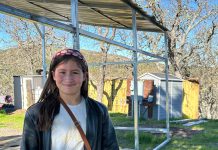Even though San Benito County is a small community, there are
hundreds of agencies and organizations that provide services to
youth. With so many agencies, there’s bound to be some inefficient
and costly overlap of services.
That’s why communities across the state are developing networks
of all such organizations to make sure community resources aren’t
wasted
– especially with the state’s lean budget times.
Even though San Benito County is a small community, there are hundreds of agencies and organizations that provide services to youth. With so many agencies, there’s bound to be some inefficient and costly overlap of services.
That’s why communities across the state are developing networks of all such organizations to make sure community resources aren’t wasted – especially with the state’s lean budget times.
Last May, the Community Assistance Network, or CAN, started up in the county, and is currently in the process of gathering information about services different youth agencies provide.
“We wanted to put together an agency to oversee all youth programs so there is communication and collaboration, not duplication,” said Kellie Guerra, grants manager with the county Office of Education and chairperson of CAN’s leadership team. “The point is to assist existing programs to utilize funding.”
Examples of organizations that deal with youth include schools, the probation department, the YMCA, the Boy and Girl Scouts, the county workforce and development department, the Hollister Youth Alliance, sports leagues, service groups and clubs, local businesses and law enforcement.
San Benito High School Superintendent Jean Burns Slater serves on CAN’s leadership committee. Schools are a big part of kids’ lives, which is why it’s important for educators to be involved with CAN, she said.
“Everyone looks to the schools to build character as well as educate. We need the whole community – we don’t have the students 24 hours a day,” Slater said.
It can be as simple as adults saying hi to kids on the street and not avoiding them or complimenting youth instead of putting them down.
It’s important to note that the group is not targeting at-risk youth, but all youth in the community, Guerra said.
“You affect every aspect (of a community) by focusing on youth,” she said. “Everybody benefits. It sounds a little Pollyanna, but everyone can support youth.”
The network decided to focus on youth because it’s not as overwhelming as looking at the whole county, Guerra said. If the group is a success, its mission statement is left in the ability to focus on the county as a whole: “Our Mission: To coordinate and to assist in the development of community resources for the well being of San Benito County youth and their families.”
The idea of such a network has been floating around for years, but never received the commitment of a separate staff. CAN serves as a go-to place to get information about the county’s services – what they offer or don’t offer – and this takes personnel, Guerra said. With agencies having to deal with less funding and less personnel because of budget cuts, the need for efficiency and streamlining is important for survival.
“You have the same service organizations providing the same programs and competing for the same grant money,” Guerra said.
Organizations can also be territorial and refuse to share information with other organizations. Sometimes, they “look at the student as a part rather than as a whole,” Slater said.
Also on CAN’s agenda is to get out information on the developmental assets – 40 positive experiences and qualities that adults possess that can positively change the environment of children and youth. These assets are divided into external and internal categories that include safety, service to others, role models, motivation, honesty and responsibility.
Working on developmental assets allow everyone in a community to look out for youth, Slater said.
“We have to have support services throughout the whole community – like attitudes, activities – so young people feel valued,” she said.
Although CAN is moving forward, it still is in the planning stages. Currently, it’s working toward getting all agencies to fill out a form listing their services and programs so Guerra can look for overlaps or holes. Also, CAN is in the process of increasing awareness, presenting its strategic plan and gathering existing assessments.
“This is not just a resource book or a list of numbers (it’s much more),” Guerra said.
The leadership team meets once a month, and an event is planned for March to recruit and inform the community. For more information or to get involved with CAN, call Guerra at 637-5393, ext. 125.








